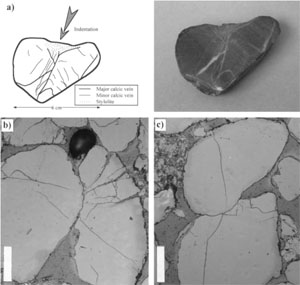| |||||||
|
|
|||||||
|
|
|||||||
| Interaction of Joints and Pressure Solutions | |||||||
|
Jointing and pressure solution operate at two time scales: relatively fast for jointing and relatively slow for pressure solution. However, the two mechanisms can interact: fracture development increases the kinetics of the pressure solution process, while pressure solution relaxes the stress between fracturing events (Gratier et al, 1999). Rocks in the same area have been observed to have been effected by both jointing and pressure solution, producing assemblages that include the products of both processes. Figure 1(a) shows a limestone pebble from Miocene conglomerate near Grenoble, France, where indentation by another pebble has occurred on the top, indicating pressure solution. Fractures radiate around the dissolution surface, suggesting that they probably developed during the dissolution process. Figures 1(b) and 1(c) show microphotographs of Miocene sandstone from the sub-Andean zone of southern Bolivia. The sandstone is coarse grained (grain size up to 0.3 to 0.4 mm), highly porous (15 to 20%), and uncemented. The observed grain indentation is the result of pressure solution at grain contacts. The indented grains frequently show one or several intragranular fractures which originate at the contact zone. The fractures are at high angle to the contact and their overall geometry is linear or smoothly curved, crossing or nearly crossing the entire grain. The geometric relationships of the grain indentation and intragranular fractures show that both types of structures were formed in a similar stress regime with shortening sub-perpendicular to compaction. Assemblages of veins and solution seams is also described in the section 'Case Study: Strike-slip Faults in Limestones with Assemblages of Veins and Pressure Solution Seams.' Gratier et al. (1999) proposed a deformation model that involves viscous-brittle cycles through geological times with ductile pressure solution on long time scales associated with brittle jointing on short time scales based on observations of natural structures and results of indention experiments. The kinetics of pressure solution are inversely proportional to the diameter of the surface of dissolution. When dissolution areas increase during progressive deformation, it is expected that the pressure solution strain rate should decrease assuming a constant remote stress. At the same time, the slow down of the strain rate increases the stress on the contact, and may lead to jointing. Joints develop fluid escape channels perpendicular to the dissolution interface and partition it into small domains of trapped fluid, and thus complete a cycle by increasing the pressure solution strain rate. This model demonstrates one possible mechanism where pressure solution and jointing are dependent on each other in the crustal deformation. | |||||||
| Reference: |
|||||||
| Gratier, J.P., Renard, F., Labaume, P., 1999 |
|||||||
|
Readme | About Us | Acknowledgement | How to Cite | Terms of Use | Ⓒ Rock Fracture Knowledgebase |
|||||||
